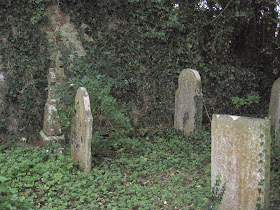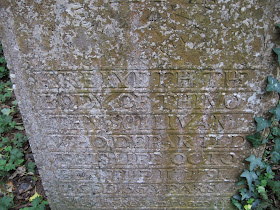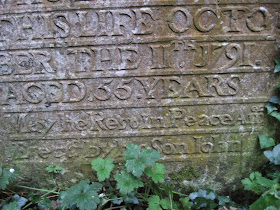There are ways to convince reluctant headstones from
abandoned cemeteries to yield their secrets. While we weren’t equipped to do
rubbings on our foray through the old graveyards of our ancestral townlands in Ireland,
apparently my husband was still inspired to do some magic, just with his camera
work alone.
Remember this headstone? The one on the far right, with the
ivy gracefully ascending its side?
When I first saw that photograph, I was sure I would never
be able to figure out what it was trying to tell us. What I hadn’t realized—not,
at least, until we returned home and I started reviewing all the material we
had accumulated on our research trip—was all that my husband had accomplished
during our visits to the cemeteries.
At the Castletown graveyard, which we visited after driving
through tiny Ballyagran, the Catholic parish my husband’s Flanagan ancestors
once called home, we had arrived at about four o’clock in the gloom of an
impending storm. While I contented myself with wandering the paths between
family plots, seeking any sign of our Flanagan or Malloy surnames, my husband
was busying himself with his photographic duties. Wandering into the more
forbidding corners where wimps like me preferred not to tread, he ferreted out the oldest and most impossible
subjects for some of his portraits.
I’m not sure how he did it—perhaps the variations in
lighting from the shifting clouds overhead worked to his advantage—but he was
able to coax the words out of that one recalcitrant block.
Here Lyeth the
Body of Thimo
Thy Sullivan
Who Departed
This Life Octo
Ber the 11th ——
Aged 55 Years
May he Rest in Peace Amen
The only challenge I had now, after the assistance from this
more revealing photographic angle, was to determine the year. I could see the
last two digits were ’91—but which century was it?
As if he were prescient, my husband had anticipated this
difficulty and arranged to take a close up shot of that segment of the
headstone. Thankfully, the contrast was enough to tell: it was a headstone from
1791. Furthermore, it provided credit for the family member who had erected the
memorial.
Erectd by his Son Iohn
I’ll assume that “Iohn” really meant John. While those two
details won’t necessarily help any family-history-seeking Sullivans to make
precise connections, it gives us a chance to add one sliver of information to
the overarching body of crowdsourced knowledge aggregated at places like Find A
Grave.
Besides, for a memorial to an Irishman born about 1736, it makes this the oldest still-legible headstone we’ve found on our own,
so far, in Ireland.
Photographs showing the placement and details for the Sullivan headstone were obtained from the graveyard at the Catholic Church ruins in Castletown (sometimes called Castletown-Conyers) in County Limerick, Ireland. Photographs courtesy Chris Stevens.
Photographs showing the placement and details for the Sullivan headstone were obtained from the graveyard at the Catholic Church ruins in Castletown (sometimes called Castletown-Conyers) in County Limerick, Ireland. Photographs courtesy Chris Stevens.




What beautiful engraving. And I've enjoyed the photos of this cemetery. Is the wall an old church? I keep seeing what appears to be a window.
ReplyDeleteYes, Wendy, the wall is indeed from the ruins of a Catholic church, possibly dating from around the early 1400s, located in the southern portion of County Limerick. The photo at the top was actually of headstones found inside the church building itself. The dim lighting was due not only to the late hour and the approaching storm, but also from the many trees growing out from the recesses of the building.
DeleteThat camera and photoshop work really did the trick!! Amazing!
ReplyDeleteIn my state, it is basically illegal to touch a gravestone with anything - so no rubbings or even cleaning birdie doo off is permitted without the owner's approval. I keep having to remind myself that "defacing in anyway" (and the law specifically says removal of plant growth) is a misdemeanor -- so I do what I can with the camera and contrast - good lighting is essential!
Interesting to learn that about state laws concerning rubbings, Iggy. Definitely need to know local restrictions before attempting anything like that.
DeleteWe learned from some videographers we work with that cloudy days sometimes provide the best lighting for photo shoots like this--lack of sun may seem too dim, but actually keeps the picture free of unpredictably cast shadows.
That last closeup was not achieved with photoshop, incidentally--just from working with the camera itself. Thankfully, there was enough relief from the engraving to capture the contrast.
Oh! That's so awesome! Congrats on being able to read that headstone!
ReplyDeleteThanks, Jana! We were certainly pleased when we got home and reviewed all the pictures. At first, I had assumed that there was no way we could read any of it--and that's how some of the other pictures of this stone looked, too. But since we're not working with actual film anymore, why not take multiple shots of each subject? Nothing to lose!
DeleteJacqi,
ReplyDeleteI want to let you know that your blog post is listed in today's Fab Finds post at http://janasgenealogyandfamilyhistory.blogspot.com/2014/10/follow-friday-fab-finds-for-october-31.html
Have a great weekend!
Thanks so much, Jana! I appreciate the mention in your blog!
DeleteI believe that I and J were pretty much interchangeable and could explain the J791 and Iohn.
ReplyDeleteGood job Chris! Photoshop can work some magic:)
ReplyDelete